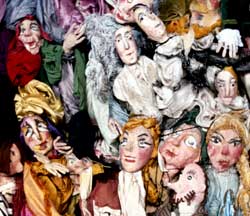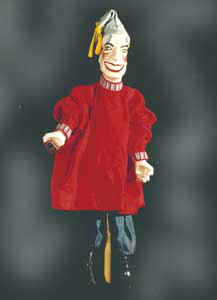
 Collezione
Maria Signorelli
Collezione
Maria Signorelli
Foreign rod and string puppets of the 20th century
The
Puppets of Maria Signorelli
The fairy tales, nursery rhymes and films
Shows with classical and modern texts, films
The ballets of Maria Signorelli
19th-20th century Italian rod and glove puppets
19th-20th century Italian marionettes
20th century foreign rod and string puppets
Sicilian, Pugliese and Neapolitan puppets
Toy
rod, glove and string puppets
Paper
and card theatres, sets and characters
Scripts
of puppet and marionette plays
Posters
of puppet theatre productions and festivals
This section comprises around seventy rod and string puppets from various countries, predominantly from Czechoslovakia and Eastern Europe.
The materials used are also very varied and range from papier mâché - for example, the Greek puppets made by Elena Thocaris Perakis, dating from the 1950s, belonging to the Barba Mitussis theatre, and the Polish peasant from the Grotesque Theatre of Cracow - to the Mexican string puppets of Death, made of wood, as also the puppets representing the mythical characters Spejbl and his son Hurvinek from Prague, made by the famous Josef Skupa, with heads carved by the sculptor Karel Nosak. The Divadlo Spejbla a Hurvinka theatre in Prague is named after these popular figures.
A French Guignol of the 1960s is also made of wood, while a couple of Hungarian rod puppets in folk costume, and the rod puppet Pisellino, probably Czechoslovakian, are made using a mixture of techniques (including pasteboard).
Others are made of cloth, such as the puppet of a girl by the famous French creator Jean Loup Temporal.
This collection is remarkable for the surprising variety of construction techniques: for example, the Hungarian Drunken Petrushka of 1965 is nothing but a transparent upturned bottle 60cm tall, with eyes made out of cork stuck on. The ‘head’ is topped by a hat. If the bottle is shaken, the liquid inside sloshes against the sides and this bestows expressivity to the character. The Magician is also very unusual, a rod puppet 120cm high from the Tandarica Theatre of Bucharest; it has two long arms made of voile and a head surmounted by a very high cone-shaped hat; however, the torso is almost nonexistent, so that by moving the arms the character can be made to suddenly appear and disappear in a flurry of veils.
The items in this section were mostly used in the theatre between the 1950s and 1970s, and some of them
were the object of exchanges between some of the most famous puppeteers and marionettists
of the time, who gave one of their creations to Maria Signorelli in exchange for one of her puppets.
